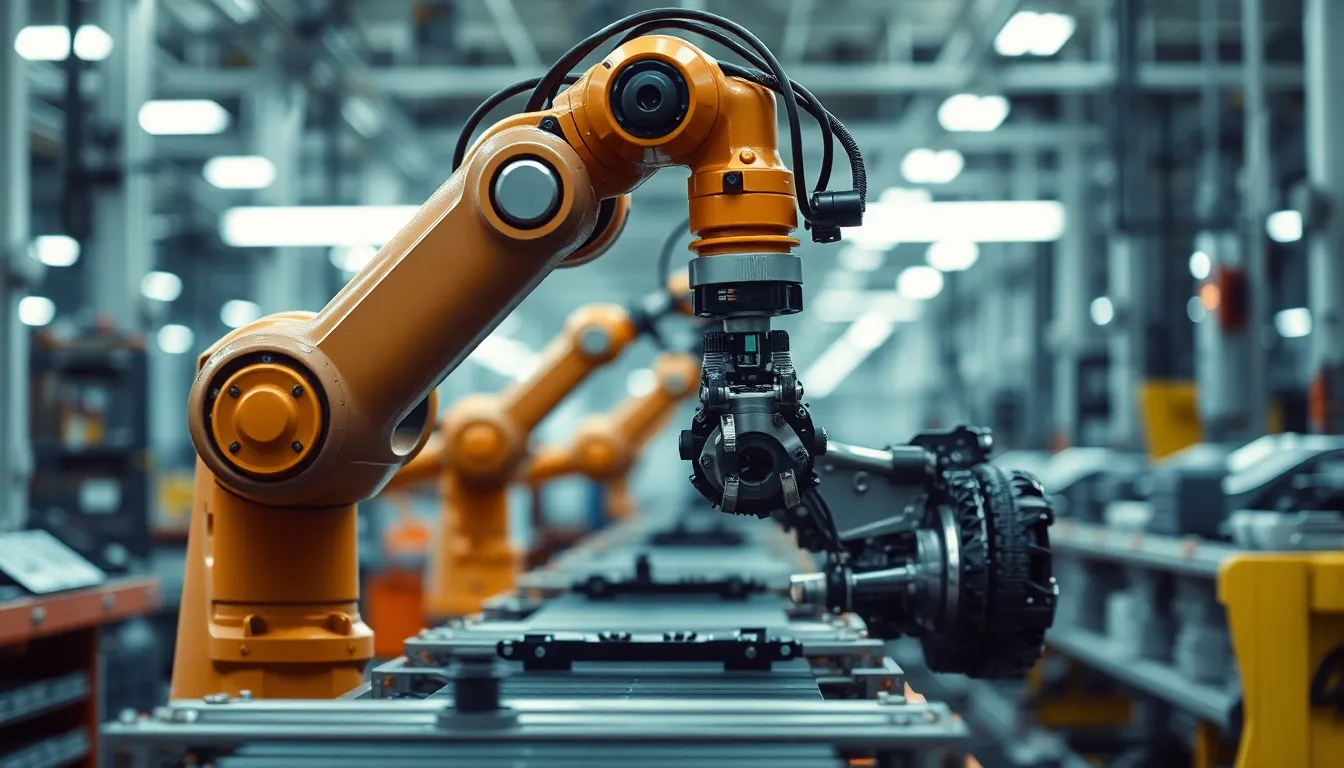In a world where robots are no longer just the stuff of sci-fi movies, their applications are popping up faster than you can say “artificial intelligence.” From vacuuming your living room to assisting in complex surgeries, these mechanical marvels are transforming everyday tasks and industries. Who knew that the future would look so much like a quirky sitcom where robots handle the heavy lifting?
Table of Contents
ToggleOverview of Robot Applications
Robots perform diverse applications across various sectors, enhancing efficiency and precision. In manufacturing, they automate assembly lines, leading to faster production rates and consistent quality. Logistics companies deploy robots for warehousing tasks, managing inventory and fulfilling orders quickly.
In healthcare, surgery-assisting robots provide high levels of accuracy, facilitating complex procedures with minimal invasiveness. Rehabilitation robots support patients in physical therapy, promoting recovery through guided exercises. These advancements reduce the burden on healthcare professionals while improving patient outcomes.
Home automation illustrates another realm where robots shine. Robotic vacuum cleaners simplify household chores, enabling more free time for users. Garden robots tend to landscaping, ensuring lawns remain well-maintained without manual effort.
The agricultural sector also benefits from robotic technology. Drones assist in crop monitoring and precision farming, enhancing yields while minimizing resource usage. Autonomous tractors take care of planting and harvesting, lowering labor costs for farmers.
Retail environments increasingly utilize robots for customer service and inventory management. Robots equipped with AI chat systems handle inquiries, providing swift assistance to shoppers. In addition, robotic systems manage shelf stock, identifying inventory shortages or discrepancies efficiently.
In the education field, robots serve as interactive learning tools. They engage students in STEM subjects, promoting critical thinking through hands-on experiences. Educators find that these applications create a more dynamic learning environment, fostering curiosity and innovation.
The evolution of robotics continues fostering new applications across industries. Innovative uses expand the potential for robots, transforming everyday tasks into more efficient processes. Applications showcase how technology integrates seamlessly into daily life, enhancing productivity and connectivity.
Industrial Robot Applications

Industrial robots significantly enhance productivity and precision across various sectors. Their integration into operations streamlines workflows and boosts efficiency.
Manufacturing Automation
Robots automate tasks on assembly lines, increasing production rates and ensuring consistent product quality. Robots handle repetitive tasks like welding, painting, and packaging with precision and speed. These machines can operate in hazardous environments, reducing workplace injuries. In addition, they adapt easily to fluctuations in production volumes. For instance, automotive manufacturers deploy robotic arms to assemble vehicles, minimizing human error. Data shows that facilities employing robotic automation can see productivity improvements of up to 30%.
Supply Chain Optimization
Robots streamline supply chain processes, especially in logistics and inventory management. They facilitate faster order fulfillment by utilizing autonomous mobile robots for transportation within warehouses. Robots efficiently manage inventory by monitoring stock levels and retrieving items with high accuracy. With real-time data, these systems enable better resource allocation and reduced operational costs. In distribution centers, robots can sort and pack products faster than manual labor. Companies implementing robotic systems often report lowering labor costs and improving delivery times by 20%, enhancing overall customer satisfaction.
Service Robot Applications
Service robots play crucial roles in various sectors, contributing to enhanced efficiency and improved user experiences. Their applications range from healthcare support to hospitality services, significantly altering traditional workflows.
Healthcare Assistance
Robots in healthcare enhance surgical precision and assist medical professionals during intricate procedures. Surgical robots increase accuracy and minimize patient recovery times. For instance, systems like the da Vinci Surgical System enable surgeons to perform delicate operations with greater control. Patient care robots deliver essential services, such as medication reminders and companionship, improving patient well-being. In rehabilitation, robots aid physical therapy, providing consistent support to patients recovering from injuries. These robots facilitate better outcomes through tailored therapy sessions and data analysis. Implementing robotics in healthcare not only boosts efficiency but also elevates the standard of care delivered.
Hospitality Services
Hospitality service robots revolutionize guest experiences in hotels and restaurants. Robots like concierge bots assist guests with information, check-ins, and deliveries, enhancing convenience. Automated food servers expedite order management, ensuring timely delivery of meals and reducing wait times. Room service robots navigate hotel corridors to deliver items directly to rooms, offering a unique touch to guest services. By streamlining processes, these robots increase operational efficiency in busy establishments. Data shows that hospitality robots can enhance guest satisfaction by 30%, proving their effectiveness in the industry. Adopting robotics in hospitality builds a personalized guest experience while improving staff workflows.
Robotics in Agriculture
Robots play a pivotal role in transforming agricultural practices. Their applications lead to enhanced efficiency and precision in various farming operations.
Precision Farming
Precision farming utilizes robotics to optimize resource usage and improve yield. Drones equipped with sensors gather data on soil health and crop conditions. Automated tractors apply fertilizers and pesticides with high accuracy, minimizing waste. These technologies enhance decision-making by providing real-time information, allowing farmers to adjust practices accordingly. As a result, farmers experience increased productivity, reducing operational costs and improving crop quality. Implementing robotics in precision farming can cut input costs by up to 20%, highlighting significant long-term benefits.
Crop Monitoring
Crop monitoring relies on robotic systems and aerial drones to oversee agricultural landscapes. Sensors track plant health, moisture levels, and growth patterns. By analyzing this data, farmers can detect issues early, such as pest infestations or diseases, reducing potential losses. Aerial inspections allow for quicker assessments of vast fields, enhancing the response time for interventions. Robotics in crop monitoring enables farmers to cover up to 100 acres in a single flight, ensuring timely and effective management of their crops. This technology creates a more sustainable and scalable approach to farming.
Emerging Trends in Robot Applications
Robotic applications are rapidly evolving, showcasing trends that enhance various industries. Increased integration of artificial intelligence in robots leads to smarter, more efficient systems. Robotics is engaged in collaborative tasks, especially in manufacturing, where human and robot interactions boost productivity.
The rise of autonomous delivery robots is notable, streamlining logistics by delivering packages more efficiently. Increased use of drones in agriculture revolutionizes crop monitoring and data collection, significantly improving yield and sustainability.
Telepresence robots are also gaining traction, allowing remote communication and interaction in corporate and educational environments. Demand for personal care robots is rising, particularly among elderly populations, enhancing quality of life through companionship and assistance.
In healthcare, advancements in robotic surgery are notable for allowing minimally invasive procedures, significantly impacting recovery times and patient outcomes. Robots equipped with machine learning algorithms adapt to dynamic environments, increasing their effectiveness across sectors.
Growing interest in robotic process automation transforms administrative tasks, minimizing human error in data processing and improving efficiency. The retail sector now sees robots utilized for inventory checks and customer interactions, enhancing the shopping experience while reducing labor costs.
Energy efficiency in robotics is becoming increasingly important, driving innovation in design and operation. Battery life and sustainable materials are priorities for developers, contributing to a greener technological future.
Overall, trends in robotic applications reflect a commitment to improving efficiency, sustainability, and user experience across various sectors.
The future of robotics is bright and full of potential. As robots continue to integrate into daily life and various industries their ability to enhance productivity and efficiency becomes increasingly evident. From healthcare to agriculture and logistics to hospitality robots are transforming how tasks are performed and improving overall outcomes.
Emerging technologies and artificial intelligence are driving innovation in this field making robots smarter and more capable of handling complex tasks. As society embraces these advancements the benefits of robotic applications will only grow leading to a more efficient and sustainable future. The journey of robotics is just beginning and its impact will be felt for generations to come.


